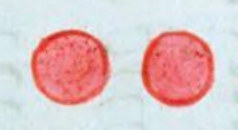ome pesos (Chav1)
This painting of the notation for two (ome), round, red simplex glyphs for the peso coin is part of a larger total in an accounting book. The word peso was a colonial introduction and loanword taken into Nahuatl from Spanish.
Stephanie Wood
The color red that was used in this case seems to be because this was part of a total calculation after some subtotals had already been shown.
Stephanie Wood
ome. psos.
ome pesos
Stephanie Wood
1578
Jeff Haskett-Wood
pesos, monedas, dinero, números, coins, money

ome, two, https://nahuatl.wired-humanities.org/content/ome
peso, a peso, a unit of money, https://nahuatl.wired-humanities.org/content/peso
dos pesos
Stephanie Wood
The Codex Chavero of Huexotzinco (or Códice Chavero de Huexotzinco), https://www.loc.gov/resource/gdcwdl.wdl_03246_001/?sp=1
The Codex Chavero of Huexotzinco (or Códice Chavero de Huexotzinco) is held by the Instituto Nacional de Antropología e Historia, México. It is published online by the World Digital Library and the Library of Congress, which is “unaware of any copyright or other restrictions in the World Digital Library Collection.”



